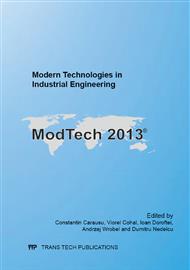p.511
p.517
p.525
p.531
p.537
p.543
p.549
p.555
p.561
Simulation of the Stewart Platform Carried out Using the Siemens NX and NI LabVIEW Programs
Abstract:
The paper presents the implementations of the control algorithm of a virtual system (Stewart platform) in the CAD/CAE system (Siemens NX) and in the NI LabVIEW supervisory and control system. The combination of both systems enables the virtual simulation and presentation of the results in relation to the chosen in the work virtual model of the Stewart platform. The virtual model of the Stewart platform with the imposed constraints and mobility limitations was built in the Siemens NX CAD/CAE system. Each of the modeled elements is based on the real components of the car simulator prepared for the persons with mobility impairments. The chosen model of a Stewart platform is a system with six degrees of freedom that is often used to build various types of simulators (e.g. flight, car). Using the NI LabVIEW software, a mathematical model of the Stewart platform was built and inverse kinematics task was implemented in relation to the model of the platform. The created mathematical model that describes the behavior of the Stewart platform was used to determine the inputs to the control system of platform actuators.
Info:
Periodical:
Pages:
537-542
Citation:
Online since:
November 2013
Keywords:
Price:
Сopyright:
© 2014 Trans Tech Publications Ltd. All Rights Reserved
Share:
Citation:


